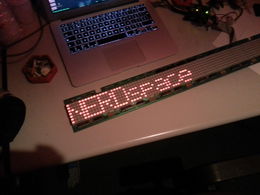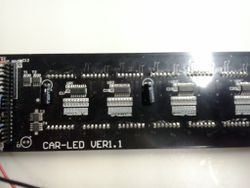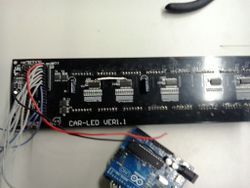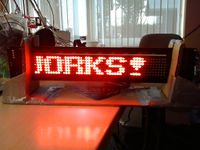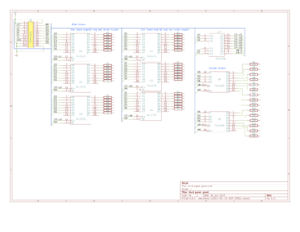LED banner wall
| LED banner wall | |
|---|---|
| Participants | Bjornl |
| Skills | Programming, electronics, Arduino |
| Status | Operational |
| Niche | Electronics |
| Purpose | Infrastructure |
| Tool | No |
| Location | |
| Cost | |
| Tool category | |
2013-07-02_23.08.34.jpg {{#if:No | [[Tool Owner::{{{ProjectParticipants}}} | }} {{#if:No | [[Tool Cost::{{{Cost}}} | }}
Small sign
Yotson modified a small LED banner sign to be controlled by an Arduino. After hooking it up to the Dockstar and reprogramming SpaceBot it is now stored somewhere. Code is available on github, based on this earlier code.
15/12/13
Petraea dragged the sign out to give it a little dusting down to find that a bunch of columns no longer worked(See inset animation)
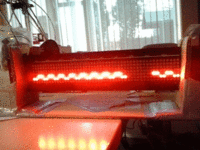 A little digging around identified that the CLK line was broken, so a simple extra wire was fitted to repair this.
A little digging around identified that the CLK line was broken, so a simple extra wire was fitted to repair this.
Large sign
DeDaan brought in a larger sign. This used to work at the previous location.
Current status
Works! It is hanging above the door from bar to Zaal 1. There's a raspberry pi connected to it, with hostname hetisbar.dhcp.nurd.space. Port 5001 udp receives text. Root-account is the usual password. If it doesn't work, reboot it using the reboot command. Sometimes it does lose connection to the arduino of the banner (no /dev/ttyACM0 appears).
Port 5003 listens to pixelflut (UDP!).
Hardware
The sign consists of 18 smaller panels of 5x7 pixels each, arranged side by side.
Software
Source code:
Protocol
The protocol between the Raspberry pi and the led banner is as follows:
The Raspi sends raw frames over serial at 9600 bps, each column in one byte, 7 bits per byte, from left to right. A frame starts with code 0x80, then 90 bytes of raw column data.
old
- https://github.com/NURDspace/BigLedPanel
- https://git.nurd.space/bigledpanel/bigledpanel/ (new location)
- First try https://gist.github.com/zarya/10f47d6b3097643f4016
- It starts to work https://gist.github.com/zarya/33fe46dac38b89f84d60
- last current code https://gist.github.com/zarya/24b3b56be5c432334539
First images
Schema's / Electronics
Arduino Pin setup
PORT_D 0 (PD0) - UART RX 1 (PD1) - D5 2 (PD6) - D3 A0 3 (PD5) - D4 A1 4 (PD4) - D6 A2 5 (PD3) - D2 6 (PD2) - D0 7 (PD1) - D1 PORT_B 8 (PB0) - MR 9 (PB1) - E1 10 (PB3) - E2 PORT_C 14 (A0,PC0) - A0 15 (A1,PC1) - A1 16 (A2,PC2) - A2
PIN OUT
01 - VCC 02 - VCC 03 - VCC 04 - SN74LS273N PIN 1 (MR) 05 - SN74LS138N PIN 5 (E2) 06 - SN74LS273N PIN 4 (D1) 07 - SN74LS138N PIN 1 (A0) 08 - SN74LS273N PIN 3 (D0) 09 - SN74LS138N PIN 2 (A1) 10 - SN74LS273N PIN 7 (D2) 11 - SN74LS138N PIN 3 (A2) 12 - SN74LS273N PIN 17 (D6) 13 - SN74LS138N PIN 4 (E1) 14 - SN74LS273N PIN 13 (D4) 15 - GND 16 - SN74LS273N PIN 8 (D3) 17 - GND 18 - SN74LS273N PIN 14 (D5) 19 - GND 20 - GND
Old info
The larger sign contains a separate control unit, programmed using a separate keyboard with a DB-9 like plug. It is attached to a PCB containing the LEDs with a 20 pin flatcable.
The control unit ( http://www.flickr.com/photos/bjornlammers/8425066292/in/photostream ) contains the following ICs:
- NEC D8049HC 195 (pre-programmed CPU)
- Motorola SN74LS373N ( http://www.alldatasheet.com/datasheet-pdf/pdf/5714/MOTOROLA/SN74LS373N.html )
- Toshiba TC5517APL (Static RAM, probably where the program is stored)
- unmarked IC, probably an EPROM
The Toshiba and the unmarked IC are in a socket, the other two are soldered to the PCB.
The LED panel ( http://www.flickr.com/photos/bjornlammers/8425075284/in/photostream ) contains:
- 6 * SN74LS273N ( http://www.alldatasheet.com/datasheet-pdf/pdf/5696/MOTOROLA/SN74LS273N.html )
- 6 * uA9668PC ( http://www.alldatasheet.com/datasheet-pdf/pdf/102338/FAIRCHILD/UA9668PC.html )
- 1 * SN74LS138N Decoder/demultiplexer ( http://www.alldatasheet.com/datasheet-pdf/pdf/5654/MOTOROLA/SN74LS138N.html )
- 2 * DM74LS259N 8-Bit Addressable Latches ( http://www.alldatasheet.com/datasheet-pdf/pdf/51060/FAIRCHILD/DM74LS259N.html )
- 4 * unmarked IC
See also this tech-archive thread: http://sci.tech-archive.net/Archive/sci.electronics.repair/2012-06/msg00302.html
